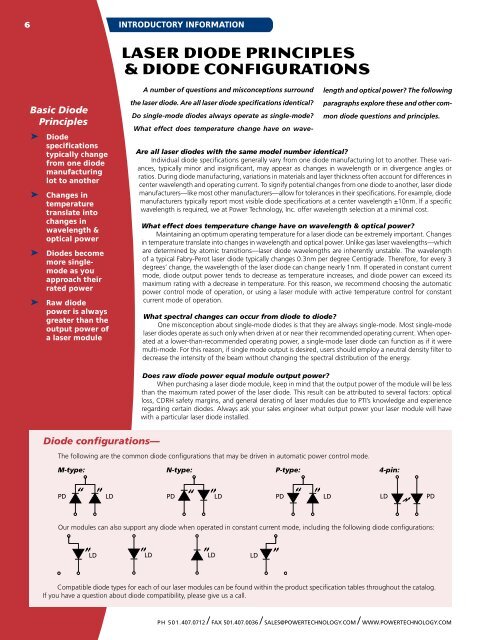Laser Diode Products for the OEM - Power Technology, Inc.
Laser Diode Products for the OEM - Power Technology, Inc.
Laser Diode Products for the OEM - Power Technology, Inc.
You also want an ePaper? Increase the reach of your titles
YUMPU automatically turns print PDFs into web optimized ePapers that Google loves.
Basic <strong>Diode</strong><br />
Principles<br />
k <strong>Diode</strong><br />
specifications<br />
typically change<br />
from one diode<br />
manufacturing<br />
lot to ano<strong>the</strong>r<br />
k Changes in<br />
temperature<br />
translate into<br />
changes in<br />
wavelength &<br />
optical power<br />
k <strong>Diode</strong>s become<br />
more single-<br />
mode as you<br />
approach <strong>the</strong>ir<br />
rated power<br />
k Raw diode<br />
power is always<br />
greater than <strong>the</strong><br />
output power of<br />
a laser module<br />
<strong>Diode</strong> configurations—<br />
INTRODUCTORY INFORMATION<br />
<strong>Laser</strong> <strong>Diode</strong> Principles<br />
& <strong>Diode</strong> Configurations<br />
A number of questions and misconceptions surround<br />
<strong>the</strong> laser diode. Are all laser diode specifications identical?<br />
Do single-mode diodes always operate as single-mode?<br />
What effect does temperature change have on wave-<br />
length and optical power? The following<br />
paragraphs explore <strong>the</strong>se and o<strong>the</strong>r com-<br />
mon diode questions and principles.<br />
Are all laser diodes with <strong>the</strong> same model number identical?<br />
Individual diode specifications generally vary from one diode manufacturing lot to ano<strong>the</strong>r. These variances,<br />
typically minor and insignificant, may appear as changes in wavelength or in divergence angles or<br />
ratios. During diode manufacturing, variations in materials and layer thickness often account <strong>for</strong> differences in<br />
center wavelength and operating current. To signify potential changes from one diode to ano<strong>the</strong>r, laser diode<br />
manufacturers—like most o<strong>the</strong>r manufacturers—allow <strong>for</strong> tolerances in <strong>the</strong>ir specifications. For example, diode<br />
manufacturers typically report most visible diode specifications at a center wavelength ±10nm. If a specific<br />
wavelength is required, we at <strong>Power</strong> <strong>Technology</strong>, <strong>Inc</strong>. offer wavelength selection at a minimal cost.<br />
What effect does temperature change have on wavelength & optical power?<br />
Maintaining an optimum operating temperature <strong>for</strong> a laser diode can be extremely important. Changes<br />
in temperature translate into changes in wavelength and optical power. Unlike gas laser wavelengths—which<br />
are determined by atomic transitions—laser diode wavelengths are inherently unstable. The wavelength<br />
of a typical Fabry-Perot laser diode typically changes 0.3nm per degree Centigrade. There<strong>for</strong>e, <strong>for</strong> every 3<br />
degrees’ change, <strong>the</strong> wavelength of <strong>the</strong> laser diode can change nearly 1nm. If operated in constant current<br />
mode, diode output power tends to decrease as temperature increases, and diode power can exceed its<br />
maximum rating with a decrease in temperature. For this reason, we recommend choosing <strong>the</strong> automatic<br />
power control mode of operation, or using a laser module with active temperature control <strong>for</strong> constant<br />
current mode of operation.<br />
What spectral changes can occur from diode to diode?<br />
One misconception about single-mode diodes is that <strong>the</strong>y are always single-mode. Most single-mode<br />
laser diodes operate as such only when driven at or near <strong>the</strong>ir recommended operating current. When operated<br />
at a lower-than-recommended operating power, a single-mode laser diode can function as if it were<br />
multi-mode. For this reason, if single mode output is desired, users should employ a neutral density filter to<br />
decrease <strong>the</strong> intensity of <strong>the</strong> beam without changing <strong>the</strong> spectral distribution of <strong>the</strong> energy.<br />
Does raw diode power equal module output power?<br />
When purchasing a laser diode module, keep in mind that <strong>the</strong> output power of <strong>the</strong> module will be less<br />
than <strong>the</strong> maximum rated power of <strong>the</strong> laser diode. This result can be attributed to several factors: optical<br />
loss, CDRH safety margins, and general derating of laser modules due to PTI’s knowledge and experience<br />
regarding certain diodes. Always ask your sales engineer what output power your laser module will have<br />
with a particular laser diode installed.<br />
The following are <strong>the</strong> common diode configurations that may be driven in automatic power control mode.<br />
M-type:<br />
PD lD<br />
N-type:<br />
PD lD<br />
P-type:<br />
PD lD<br />
4-pin:<br />
Our modules can also support any diode when operated in constant current mode, including <strong>the</strong> following diode configurations:<br />
lD lD lD<br />
lD<br />
lD PD<br />
Compatible diode types <strong>for</strong> each of our laser modules can be found within <strong>the</strong> product specification tables throughout <strong>the</strong> catalog.<br />
If you have a question about diode compatibility, please give us a call.<br />
PH 501.407.0712 / FAX 501.407.0036 / sAles@<strong>Power</strong>tecHnology.com / www.<strong>Power</strong>tecHnology.com


